Bamiyan – Three Years After
In July 2003 I visited the valley of Bamiyan for the first time. Along the way, there were war remnants to remind all visitors that the land was scrapped by the long period of wars. The trip in 2003 was full of horror and mistery, when seeing the skeletons of tanks scattered on the side of dusty and windy roads.
Today, almost three years after, I went to Bamiyan again, alone. The public transport, as what it was in three years ago, started very early in the morning from Kabul. The difficulty of travelling from Kabul is that there are too many bus stations, and each bus station only has vehicles to go to a certain destination. Therefore it’s essential to make sure from which station start the vehicle you are going to take. The other difficulty is that the timing, most buses in three years ago would be all departed after 6, so passengers should come around 4 or 5 in the morning. The problem is if the bus station located far from the residential area, then another taxi would be needed, and they might be scarce in dark mornings.
The 4WD comfortable cars to go to Bamiyan depart from Kote Sangi (Pul-e-Koshta) and cost 400 Af to cover that 150 km distance. Sounds quite expensive, but the fact is that the distance requires about 8 or 9 hours of driving time, with average speed less than 20 km/hour. The road is very bumpy and dusty, as it was in three years ago.
But leaving Kabul, the sky changed dramatically. It was deep blue in the village areas. The houses were very simple architected, mostly made from mud and only in uniform colour: brown. The feeling of being thrown back to the past was even stronger, when old man with white long beard, traditional dress and cap, sitting on his little donkey (full-loaded with sacks of God knows what it was), passing slowly, just as time never flows. Children was also passing through the muddy road with their cattle, and when the car passed, they were ‘showered’ by the dust. Everybody seemed happy, and laughed.
The village road doesn’t show the atmosphere of horror and quietness as it was in three years ago. The valley showed heavenly scene with its dramatic peaks and deep green grass carpet. It reminded me to the scenery of Kyrgyzstan pastureland in summer. Peaceful.
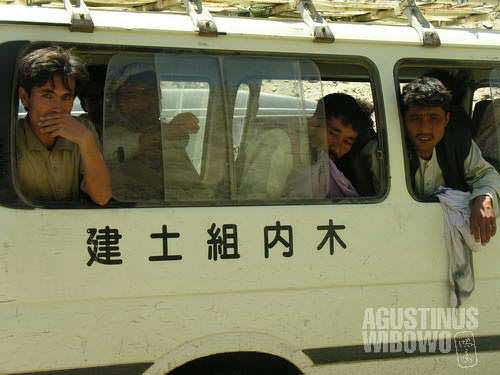
They love Chinese characters. They use it merely for decoration, and do not worry at all about the meaning
When we passed a muddy road, the whole path of it was covered by water, our car sanked in the mud. The water was as deep as my knee, and it was mere mud. All male passengers (there were 6 of male passengers, plus one lady sitting in front), went down and tried hard to move the car from the mud. Pushing, pulling,… it was all vain. They also tried to put some stones to enable the wheels to rotate, but the mud was too deep for this attempt. We were waiting for another vehicles to pull our car out. The first passing vehicle just merely refused and ran away. The second stopped a while, and said that they couldnt help us. Not until the third one, that our car was tied with a rope and pulled by that vehicle. But the rope was even not strong enough for pulling out completely. Luckily our car successfully made its attempt to leave the mud pond after that attempt.
I arrived in Bamiyan at 2, after eight hours of journey. I visited Radio Bamiyan which was recommended by my friends in Pajhwok. Three years ago there was no radio station in this beautiful green village, but now they even have Internet Cafe. Hadi Gafari, the man-in-charge, told me that it cost them 600 dollars per month to maintain Internet connection for this office, with the assistance of the satelite dish. The bazaar looks much more happening that it was in three years back, with many shops selling everything from daily needs to books. Three years ago, the acommodation was monopoly of Mama Najaf Restaurant, expensive and dirty. But now, the competition seemed much harsher as there are more than four hotels in one strip of the main road. There are Television Bamiyan (not sure when it will start operating), internet cafe (60 Af per hour), souvenir shops (very deserted as almost no foreigners hanging around), and even gym (with big banner written: ‘buddy building).
The people of Bamiyan, which is located in Hazarajat – the heartland of Afghanistan, are the Hazaras. They have Mongoloid physical appearance, with slinted eyes and small noses, short bodies. The face is quite similar to Kyrgyz or Kazakh or Mongol. It was said that they were the descendants of Genghiz Khan. The Bamiyan valley was the center of Buddhist pilgrimate in its glorious history, but it had been completely Islamized. The legend said it was the Hazrat Ali (the cousin and son-in-law of the Prophet) himself who converted the valley with his supernatural power. The Hazaras are Shiah, while the majority of Afghanistan are Sunnis. They still perform the bloody festival of Ashura, which was forbidden under Taliban law. The Hazaras had been subject of killings in last few years of wars, and many of them fleed to neighboring countries for shelter. But now, the life in Bamiyan is again flourished, with hard money, hopeful people, and cheerful tourists (to see the remnants of the big Buddha statues).
For breakfast, people likes to eat dry nan. To enase it to swallow passing the throat, it is usually helped by the tea. Iranian way of drinking tea is by putting candy in the mouth and drink the plain tea. But for breakfast, this method is replaced by putting sugar at the bottom of the glass (mostly, if not all, Made in Indonesia) and pour the hot tea to the glass. The level of sweetness is decided by the number of sugar, the temperature of the tea, the angle of pouring, and the flow speed of the tea water. Mixing by spoon is not common. Eating is also mostlywith done with hand without other equipments. As in Pakistan, eating on tables is uncommon. In Afghanistan, even in restaurants, people eat on the floor. People sit in a row in carpeted and matressed area. There would be plastic sheet to be prepared where the food would be placed on. This is to prevent the carpet to be dirtied by the food. Food is always started by “bismillah” (in the name of Allah) and ended by “amin” gratitude gesture. The boy servants (mostly underaged) then will clean the the space and roll up the plastic sheet for the next use.
Shahr-e-Nau, the New City, is the name of Bamiyan bazaar. Bamiyan is one street village. And the main street got much longer compared it was in 2003. The new city was built actually after the wars by the returning refugees. The whole city was completely destroyed under Taliban. The ruin of the old city can be seen still near the Buddha statues. Another settlement in Bamiyan was those along the way heading to Ajdahar or Band-e-Amir. The life there was more difficult, as this area was not as green as the Bamiyan valley, instead it was dusty and dry.
Bamiyan is a generator town, like most other places in Afghanistan (even Kabul still has to rely on generators). It is surprising that this country is blessed by high mountains with strong river streams, but electricity is so scarce. The government opted to import electricity from Kyrgyzstan and Tajikistan instead of developing their own electricity generator or a dam. Some blamed that the parliament of Afghanistan was full of warlords and they didnt have knowledge about building a country. Every house in Bamiyan has their own generator to turn on the lighting and TV, now added with DVD to play the newest Iranian and Bollywood movies.
The toilet in Bamiyan now had mushroomed, compared to the single awful one near Mama Najaf. UN Habitat has built a lot of new ones. Sanitation has improved a lot in Bamiyan in last three years. The toilet is usually just a hole on the floor. The location of the toilet is usually elevated from the ground, so that the faeces can be easily hovered up to be used as fertilizer. As Muslims, people prefer to wash with water rather than using the toilet paper. The water is carried in a pot with long neck, very convinient to reach “difficult parts” of the body. The neck of the pot is longer than that of Pakistan.
Afghanistan has developed fast. And Bamiyan also changed.

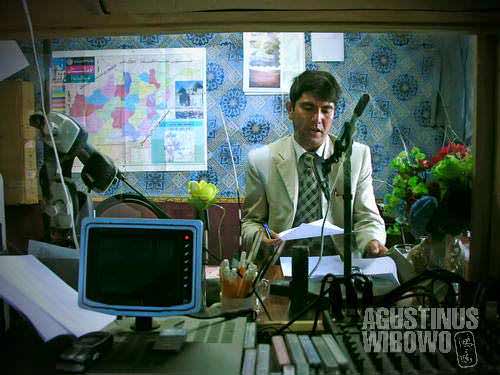
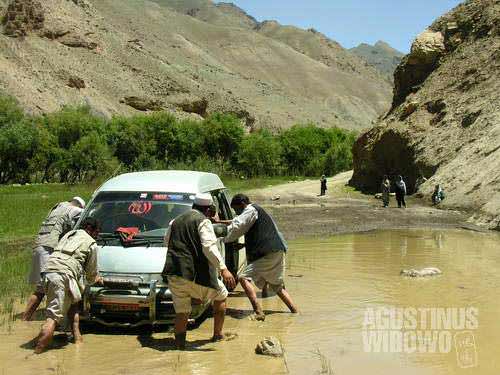


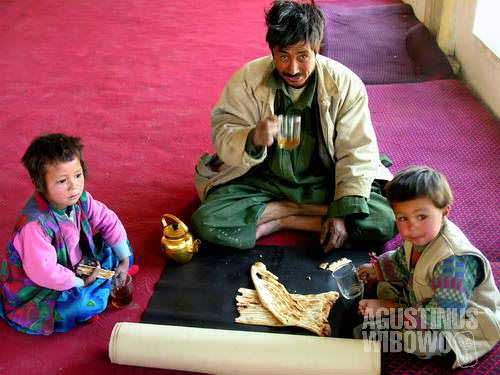
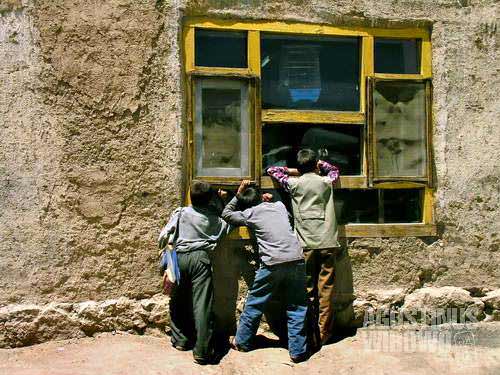

Leave a comment